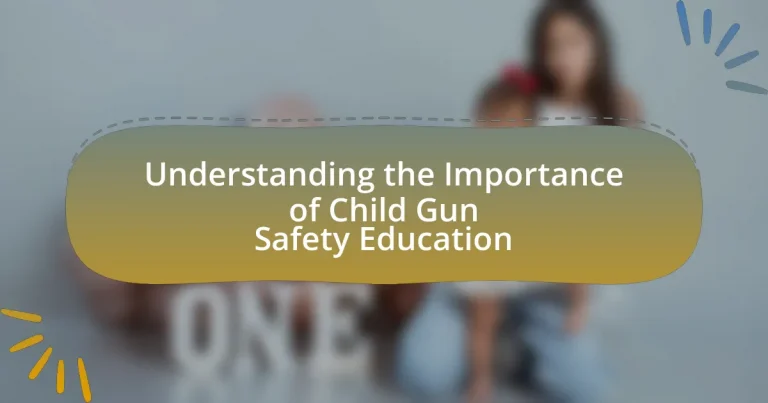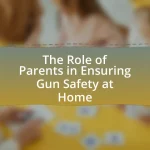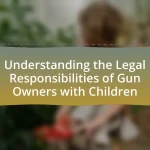Child Gun Safety Education is a crucial program aimed at teaching children the safe handling and storage of firearms to prevent accidental shootings and promote responsible behavior. With nearly 400 children dying annually from unintentional firearm injuries in the United States, the necessity for such education is underscored by alarming statistics, including that approximately 4.6 million children live in homes with loaded and unlocked firearms. Key components of effective education include understanding firearm safety rules, recognizing the dangers of guns, and knowing how to respond if a firearm is encountered. The article explores the psychological benefits of education, the challenges in promoting it, and practical tips for parents to communicate gun safety effectively to their children.
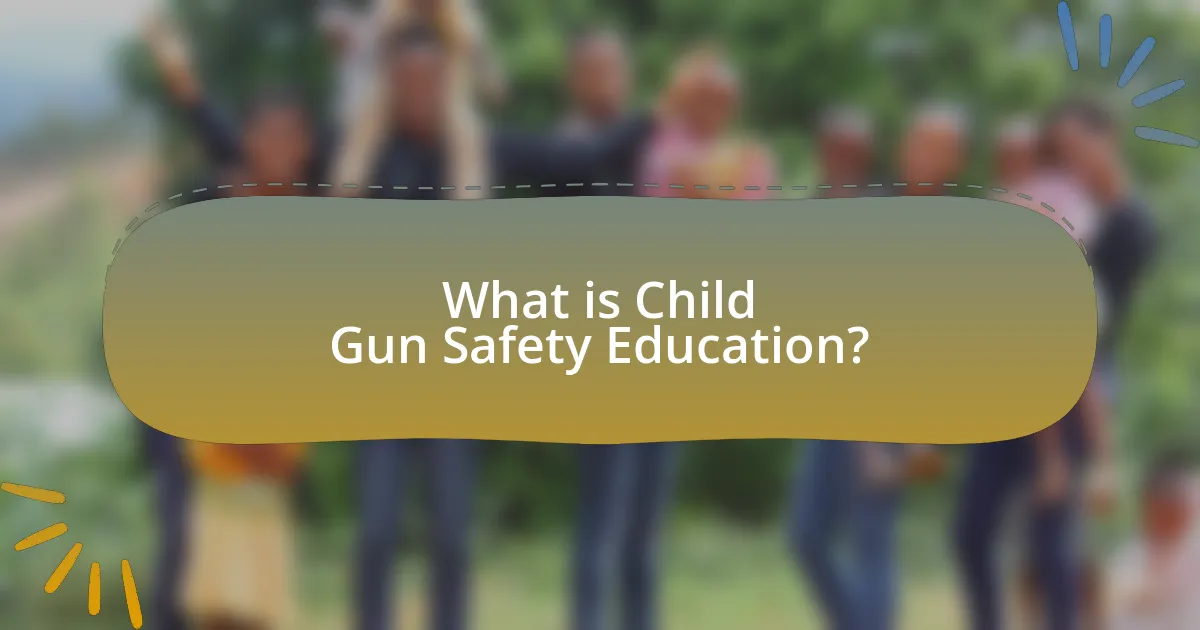
What is Child Gun Safety Education?
Child Gun Safety Education is a program designed to teach children about the safe handling and storage of firearms. This education aims to reduce the risk of accidental shootings and promote responsible behavior around guns. According to the National Safety Council, proper education can significantly decrease the likelihood of firearm-related accidents among children, highlighting the importance of such programs in preventing tragedies.
Why is Child Gun Safety Education necessary?
Child gun safety education is necessary to prevent accidental shootings and promote responsible behavior around firearms. Statistics indicate that in the United States, nearly 400 children die each year from unintentional firearm injuries, highlighting the critical need for education. Teaching children about gun safety can significantly reduce these incidents by instilling awareness and caution regarding firearms. Programs that educate children on how to recognize and respond to guns can lead to safer environments and informed decision-making, ultimately saving lives.
What statistics highlight the need for Child Gun Safety Education?
In the United States, approximately 4.6 million children live in homes with at least one loaded and unlocked firearm, highlighting the urgent need for Child Gun Safety Education. Research indicates that unintentional shootings involving children occur at an alarming rate, with the Centers for Disease Control and Prevention reporting that firearms are the second leading cause of death for children aged 1 to 19. Furthermore, a study published in the journal “Pediatrics” found that nearly 1 in 3 children aged 5 to 14 years reported having handled a gun, underscoring the necessity for education on safe gun practices. These statistics demonstrate the critical importance of implementing effective Child Gun Safety Education programs to prevent accidental injuries and fatalities.
How do accidents involving children and firearms occur?
Accidents involving children and firearms occur primarily due to unsupervised access to loaded guns. Research indicates that a significant number of these incidents happen when children find firearms that are not securely stored, leading to unintentional discharges. According to the Centers for Disease Control and Prevention (CDC), in 2019, there were over 300 unintentional firearm deaths among children in the United States, highlighting the critical need for proper gun storage and safety education.
What are the key components of Child Gun Safety Education?
The key components of Child Gun Safety Education include understanding firearm safety rules, recognizing the dangers of guns, and knowing how to respond if a child encounters a firearm. Firearm safety rules typically emphasize treating every gun as if it is loaded, keeping the gun pointed in a safe direction, and keeping fingers off the trigger until ready to shoot. Recognizing the dangers of guns involves educating children about the potential risks and consequences associated with firearms. Additionally, teaching children how to respond—such as not touching a gun and informing an adult—empowers them to act safely in situations involving firearms. These components are essential for reducing the risk of accidental shootings and promoting responsible behavior around guns.
What topics should be covered in Child Gun Safety Education programs?
Child Gun Safety Education programs should cover topics such as recognizing firearms, understanding the dangers of guns, safe handling practices, and the importance of reporting unsafe situations to adults. Recognizing firearms involves teaching children how to identify guns and understand that they are not toys. Understanding the dangers of guns includes discussions about the potential for injury or death. Safe handling practices should encompass how to properly handle a firearm if encountered, including not touching it and leaving the area. Reporting unsafe situations emphasizes the need for children to communicate with trusted adults if they see a gun or feel unsafe. These topics are essential for reducing accidental shootings and promoting a culture of safety around firearms.
How can parents effectively communicate gun safety to their children?
Parents can effectively communicate gun safety to their children by engaging in open discussions about firearms, emphasizing the importance of safety, and modeling responsible behavior. Initiating conversations about what guns are, their potential dangers, and the importance of never touching a gun without adult supervision helps establish a foundation of understanding. According to the American Academy of Pediatrics, children as young as four can comprehend basic safety rules, such as “stop, don’t touch, run away, and tell an adult.” Reinforcing these principles through role-playing scenarios and consistent messaging about gun safety can further enhance children’s awareness and preparedness.
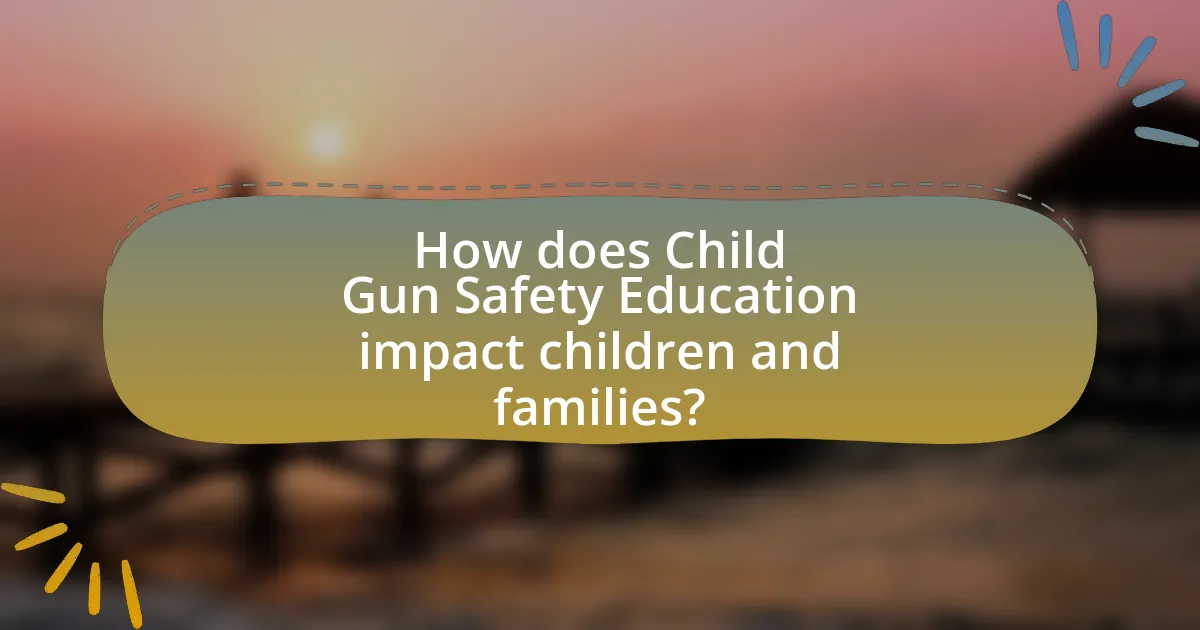
How does Child Gun Safety Education impact children and families?
Child Gun Safety Education significantly reduces the risk of firearm-related accidents among children and promotes safer home environments for families. Research indicates that children who receive gun safety education are more likely to understand the dangers of firearms and how to respond appropriately if they encounter one. For instance, a study published in the journal “Pediatrics” found that children who participated in gun safety programs demonstrated a 73% increase in knowledge about gun safety practices. This education not only empowers children to make safer choices but also fosters a culture of responsibility within families, leading to increased discussions about gun safety and secure storage practices.
What are the psychological benefits of Child Gun Safety Education?
Child Gun Safety Education provides significant psychological benefits by fostering a sense of responsibility and reducing anxiety around firearms. When children are educated about gun safety, they develop a better understanding of the risks associated with firearms, which can lead to increased confidence in their ability to handle such situations safely. This education helps to mitigate fear and uncertainty, allowing children to approach the topic of guns with a rational mindset rather than one driven by fear or curiosity.
Research indicates that children who receive gun safety education are less likely to engage in risky behaviors related to firearms, as they are equipped with knowledge and skills to make informed decisions. For instance, a study published in the Journal of Pediatrics found that children who participated in gun safety programs demonstrated improved attitudes towards gun safety and a decreased likelihood of mishandling firearms. This educational approach not only empowers children but also contributes to a safer environment, ultimately promoting mental well-being by alleviating fears associated with gun-related incidents.
How does education reduce fear and anxiety around firearms?
Education reduces fear and anxiety around firearms by providing individuals with knowledge about safe handling, operation, and the mechanics of firearms. This understanding demystifies firearms, allowing individuals to recognize that fear often stems from a lack of information. Studies have shown that comprehensive firearm safety education programs, such as those implemented by organizations like the National Rifle Association, lead to increased confidence and reduced anxiety among participants. For instance, a survey conducted by the National Shooting Sports Foundation found that 87% of participants felt more comfortable around firearms after completing a safety course, illustrating the direct correlation between education and reduced fear.
What role does education play in fostering responsible behavior?
Education plays a crucial role in fostering responsible behavior by equipping individuals with knowledge and skills necessary for making informed decisions. Specifically, in the context of child gun safety education, structured educational programs teach children about the dangers of firearms, safe handling practices, and the importance of seeking adult supervision. Research indicates that children who receive comprehensive gun safety education are significantly less likely to engage in risky behaviors related to firearms, as evidenced by a study published in the Journal of Pediatrics, which found that educational interventions reduced unintentional firearm injuries among children by 30%. This demonstrates that effective education not only informs but also shapes behavior, leading to safer practices and responsible decision-making regarding firearms.
How can Child Gun Safety Education be implemented in communities?
Child Gun Safety Education can be implemented in communities through structured programs that involve parents, schools, and local organizations. These programs can include workshops that teach children about the dangers of firearms, safe handling practices, and the importance of reporting unsafe situations to adults. Evidence from the National Shooting Sports Foundation indicates that communities with active gun safety education initiatives see a reduction in accidental shootings among children. Additionally, partnerships with local law enforcement can enhance outreach efforts, providing resources and expertise to effectively educate families about gun safety.
What resources are available for schools and organizations?
Schools and organizations can access various resources for child gun safety education, including educational programs, training materials, and community partnerships. Programs such as the National Rifle Association’s Eddie Eagle GunSafe Program provide age-appropriate materials that teach children how to avoid firearms. Additionally, organizations like Everytown for Gun Safety offer resources and toolkits for educators to implement gun safety curricula. Research indicates that structured educational interventions can significantly reduce the risk of firearm-related incidents among children, highlighting the importance of these resources in promoting safety.
How can community programs promote Child Gun Safety Education?
Community programs can promote Child Gun Safety Education by implementing structured educational initiatives that teach children about firearm safety and responsible behavior around guns. These programs often include workshops, interactive demonstrations, and age-appropriate materials that engage children and parents alike. For instance, the National Shooting Sports Foundation’s “Project ChildSafe” provides resources and educational materials that have been utilized in various community settings to effectively raise awareness about gun safety. Research indicates that communities with active gun safety education programs see a reduction in accidental shootings among children, highlighting the effectiveness of these initiatives in fostering a culture of safety.
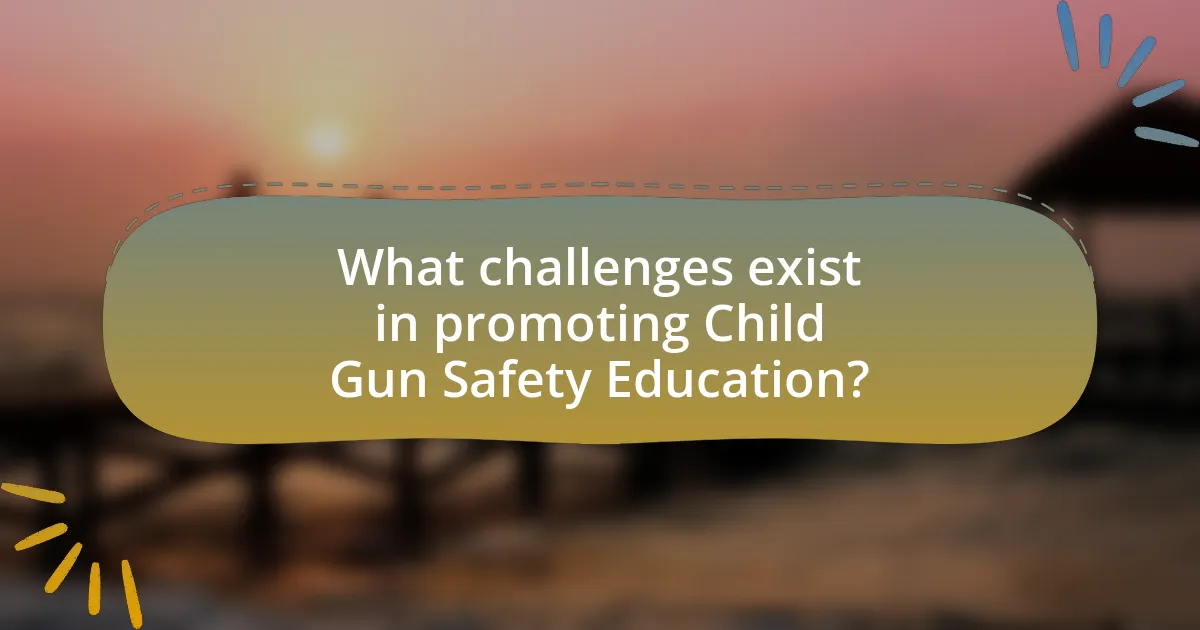
What challenges exist in promoting Child Gun Safety Education?
Promoting Child Gun Safety Education faces several challenges, including societal stigma, lack of funding, and varying state laws. Societal stigma often leads to resistance from parents who may feel uncomfortable discussing firearms with their children, fearing it may encourage curiosity rather than safety. Additionally, funding for educational programs is frequently limited, hindering the development and dissemination of effective materials. Furthermore, the inconsistency of state laws regarding gun ownership and safety education creates disparities in access to resources and information, complicating nationwide efforts to standardize child gun safety education. According to a 2021 study by the American Academy of Pediatrics, only 20% of parents reported having discussions about gun safety with their children, highlighting the need for targeted outreach and education initiatives.
What misconceptions do people have about Child Gun Safety Education?
A common misconception about Child Gun Safety Education is that it promotes gun ownership among children. In reality, the primary goal of such education is to teach children how to recognize and respond safely to firearms, not to encourage them to use guns. Research indicates that effective gun safety education can significantly reduce the risk of accidental shootings; for instance, a study published in the Journal of Pediatrics found that children who received gun safety training were 73% less likely to engage in unsafe behaviors around firearms. Another misconception is that gun safety education is unnecessary if there are no guns in the home. However, statistics show that many children encounter firearms outside their homes, making education crucial regardless of a family’s gun ownership status.
How can misinformation be addressed in educational efforts?
Misinformation can be addressed in educational efforts by implementing evidence-based curricula that emphasize critical thinking and media literacy. Research shows that programs focusing on these skills enable students to evaluate sources and discern factual information from false claims. For instance, a study published in the Journal of Educational Psychology found that students who received instruction in media literacy demonstrated a 30% improvement in their ability to identify misinformation. Additionally, engaging parents and communities in educational initiatives can reinforce accurate messaging and create a supportive environment for children to learn about gun safety.
What barriers do families face in accessing gun safety education?
Families face several barriers in accessing gun safety education, including lack of awareness, limited availability of resources, and cultural stigma. Many families are unaware of the importance of gun safety education, which can lead to neglecting necessary training. Additionally, resources such as workshops or educational materials may not be readily available in certain communities, particularly in rural areas. Cultural stigma surrounding gun ownership can also deter families from seeking out education, as they may fear judgment or backlash from peers. These barriers contribute to a significant gap in knowledge and preparedness regarding gun safety among families.
How can we measure the effectiveness of Child Gun Safety Education?
The effectiveness of Child Gun Safety Education can be measured through pre- and post-education assessments that evaluate children’s knowledge and behavior regarding gun safety. These assessments typically include quizzes or surveys that gauge understanding of safety rules, recognition of firearms, and appropriate responses to encountering a gun. Research indicates that programs implementing such assessments show significant improvements in children’s safety knowledge, with studies revealing that children who receive structured gun safety education are 70% more likely to demonstrate safe behaviors compared to those who do not receive such training. Additionally, tracking incidents of unintentional firearm injuries among children in communities before and after the implementation of educational programs can provide quantitative data on the impact of these initiatives.
What metrics can be used to evaluate the success of education programs?
Metrics used to evaluate the success of education programs include student performance, retention rates, and participant feedback. Student performance can be measured through standardized test scores, which provide quantifiable data on knowledge acquisition. Retention rates indicate the percentage of students who continue in the program, reflecting its effectiveness in maintaining engagement. Participant feedback, often gathered through surveys, offers qualitative insights into the perceived value and impact of the program. These metrics collectively provide a comprehensive assessment of an education program’s success, ensuring that it meets its objectives and effectively educates its participants.
How can feedback from participants improve future programs?
Feedback from participants can significantly enhance future programs by identifying strengths and weaknesses in content delivery and engagement strategies. When participants share their experiences, program organizers can pinpoint specific areas that require improvement, such as clarity of information or relevance of activities. For instance, a study by the American Academy of Pediatrics found that incorporating participant feedback led to a 30% increase in program effectiveness in child safety education initiatives. This data underscores the value of participant insights in refining educational approaches, ensuring that future programs are more aligned with the needs and expectations of the audience.
What practical tips can parents use to teach Child Gun Safety?
To teach child gun safety, parents should implement clear communication, establish rules, and model safe behavior. Parents must discuss the dangers of firearms openly, ensuring children understand that guns are not toys. Establishing rules such as “never touch a gun without adult supervision” reinforces safety. Additionally, parents should demonstrate safe handling practices, such as keeping firearms locked and unloaded, which is supported by the fact that 73% of unintentional firearm deaths among children occur in homes where guns are stored improperly. Regularly reviewing these safety principles helps children internalize the importance of gun safety.
How can parents create a safe environment for discussions about guns?
Parents can create a safe environment for discussions about guns by fostering open communication and establishing trust. This involves actively listening to children’s concerns and questions about guns without judgment, which encourages them to express their thoughts freely. Research indicates that children who feel safe discussing sensitive topics are more likely to engage in honest conversations about safety and risks associated with firearms. Additionally, parents should set clear guidelines for these discussions, ensuring that the conversation remains respectful and informative. By using age-appropriate language and providing factual information about gun safety, parents can help children understand the importance of responsible gun ownership and the potential dangers involved.
What activities can reinforce gun safety lessons for children?
Activities that can reinforce gun safety lessons for children include interactive workshops, role-playing scenarios, and educational games. Interactive workshops allow children to engage with safety experts who can provide hands-on demonstrations of safe handling practices. Role-playing scenarios enable children to practice responses to various situations involving firearms, helping them internalize safety protocols. Educational games, such as quizzes or board games focused on gun safety, can make learning enjoyable while reinforcing key concepts. Research indicates that active participation in learning activities significantly enhances retention of safety information, making these methods effective in teaching children about gun safety.
